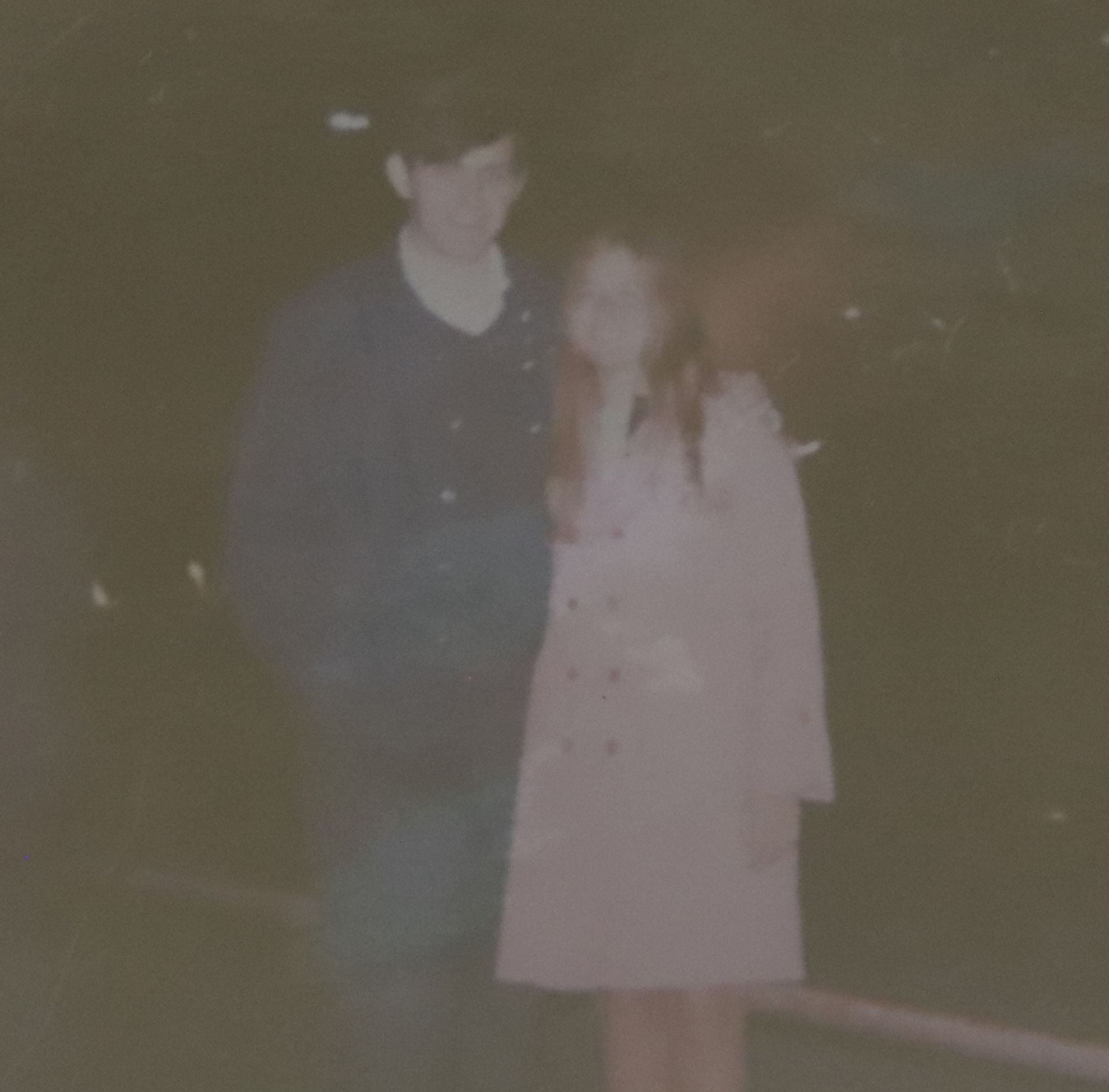
The tragedy of Bill and Mary: an Ohio State cold case, revisited
The story of Mary and Bill is known as one of Ohio State’s coldest homicide cases. Yet their story has faded from the memory of the public and swept across the desks of many homicide detectives throughout the decades to no avail. That is, until a producer started a podcast this summer revisiting the tragic crime that stole the lives of the young couple. Now, decades later, detectives say they are “cautiously optimistic” this case can finally be solved.
Amani Bayo
John R. Oller Special Projects Editor
Background
French students learn the phrase, “Joie de vivre,” early on, but two Ohio students weren’t truly introduced to the joy of life until they met each other.
William “Bill” Sproat, a graduate student at Ohio State, and Mary Petry, a third-year at the College of Mount St. Joseph in Cincinnati — both introverted, devout Catholics — first met through a mutual friend. Their shared love and practice of French culture took care of the rest.
Despite the 116 miles between them, their thoughts were always of each other. Those who knew them saw the couple as young and in love.
Because of this connection, it wasn’t surprising when Petry grabbed a last-minute ride to Columbus on a cold February Friday night to spend a quiet weekend with Sproat in his South Campus apartment, escaping the stressful reality of student life and relishing in their memories abroad in France.
Feb. 27 should have been like any other night. Except it was anything but.
That night, someone crept from the shadows and stole the lives of Sproat and Petry. The person who bound, beat and stabbed the couple has remained unknown ever since.
That night was 53 years ago.


Mary Petry (left) and Bill Sproat (right) on their driver’s licenses in high school
Courtesy of Justin Glanville
The story of Bill and Mary, now one of Ohio State’s oldest cold cases, has faded in and out of the public eye and swept across the desks of many homicide detectives throughout the decades to no avail.
A new podcast from Ideastream Public Media, “Mary and Bill: An Ohio Cold Case,” produced by the son of a couple who was friends with Sproat, aired this summer, in an attempt to bring new light to the tragic story.
An examination of Lantern archives, interviews with police and individuals connected to the case suggest it “got lost” due to the lack of investigative technology, rise in off-campus violence and the distraction of civil unrest in the Vietnam War era.
With the advent of the new podcast and family members’ persistence, yet another review of the case has led police to say a new technique involving DNA testing may help them finally solve the mystery.
The sisters of both victims say they aren’t interested in punishment as much as they are in knowing the killer’s motive.
“She was always there for me when I needed her,” Petry’s twin sister, Martha Petry said. “I just want to know why was this person willing to hurt these other people — I would just like closure.”
Sproat, originally from Pennsylvania, earned his bachelor’s in French at Xavier University. He was in his first year as a graduate student at Ohio State when he was murdered. Mary Petry was a third-year in French at the College of Mount St. Joseph.
“I actually do have some hope now that there might be a hit,” Patricia Sproat Loeliger, Sproat’s sister, said. “But at this point, I just want to know why and why so brutally.”
Fellow French graduate students referred to Sproat as “a perfectly gentle person and a good serious student,” according to Lantern archives.
While an undergraduate, Sproat would travel abroad to France under the Xavier University Fredin Memorial Scholarship.
The murders were devastating for the families. Loeliger said Sproat’s sudden absence was heavily felt in the family.
“There’s always the empty chair,” Loeliger said. “He had all these academic accolades and my parents were very proud of him. You’re always wondering if it would have been easier for them if it had been me.”
Loeliger said she last spoke to Sproat the Sunday before he was murdered and remembered him promising to introduce Mary Petry to the family that Easter.
“There’s always the empty chair,” Loeliger said.
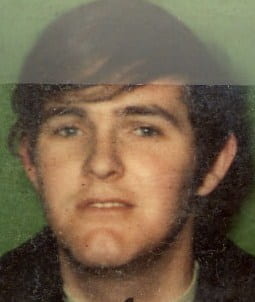
William “Bill” Sproat, 22, was in his first year as a graduate student studying French at The Ohio State University
Courtesy of Justin Glanville
“I was so angry when I was 21, 22,” Loeliger said. “If there was a gun, I would have shot the person.”
The circumstances of the crime were especially shocking and confusing to the Sproat family, Loeliger said, because of Bill Sproat’s gentle nature.
“He was not a fighter kind of person,” Loeliger said. “He was quiet but fun-loving, very conscientious about his studies, yet not nerdy,” Loeliger said.
Mary Petry, originally from Portsmouth, Ohio, who was in her third year at the College of Mount St. Joseph in Cincinnati, would later study in France under the same scholarship Sproat previously had.
Martha Petry also describes her as the academic scholar of the family who even won an award for the best international student for her time abroad in the summer of 1968.
She said they shared a bond knowing they had completely different personalities despite their identical features.
“All of my life I tried to be different from Mary, so bright, so brilliant, so intellectual,” Martha Petry said.

Mary Petry, 20, was a junior studying French at the College of Mount St. Joseph in Cincinnati
Courtesy of Justin Glanville
Martha Petry said she had met Sproat on three different occasions and he seemed “to fit right in” to their close-knit family.
She remembered Mary Petry as someone with a clear vision for her future, really wanting Martha Petry to like Sproat because of how important he was to her.
“Mary did not have a doubt in the world about her pathway,” Martha Petry said. “She was gonna marry Bill, she was going to teach at one of the Catholic high schools until both of them could go over to France and live their lives.”
Martha Petry said she struggled to imagine how horrific Sproat and Mary Petry’s last moments were. She’s been able to get by knowing their last moments were with each other.
Their deaths shocked communities throughout the Midwest as victims of a murder so gruesome that many people drew comparisons to the Manson murders, where victims were slain through stabbing and bludgeoning just one year before the deaths of Sproat and Mary Petry.
“They looked like pretty good kids,” former State Attorney General Paul W. Brown told a former Lantern reporter in 1970 days after the bodies were discovered. “Someone is going to be awfully shocked.”
Campus safety in the ’70s
After a night out with friends, Sproat’s roommate and childhood friend returned to their apartment at 178 ½ W. Eighth Ave. the morning of Feb. 28, 1970, to see a horrific sight of Sproat, 22, and his girlfriend Mary Petry, 20, deceased.
The night before, between 7 p.m. and 10 p.m., the couple was brutally murdered. According to police reports, a lack of forced entry or apparent robbery supports the assumption the couple knew the assailant.
Despite police receiving hundreds of tips in the immediate aftermath of the crime, the case ultimately ran cold after a few months, according to Lantern reports.
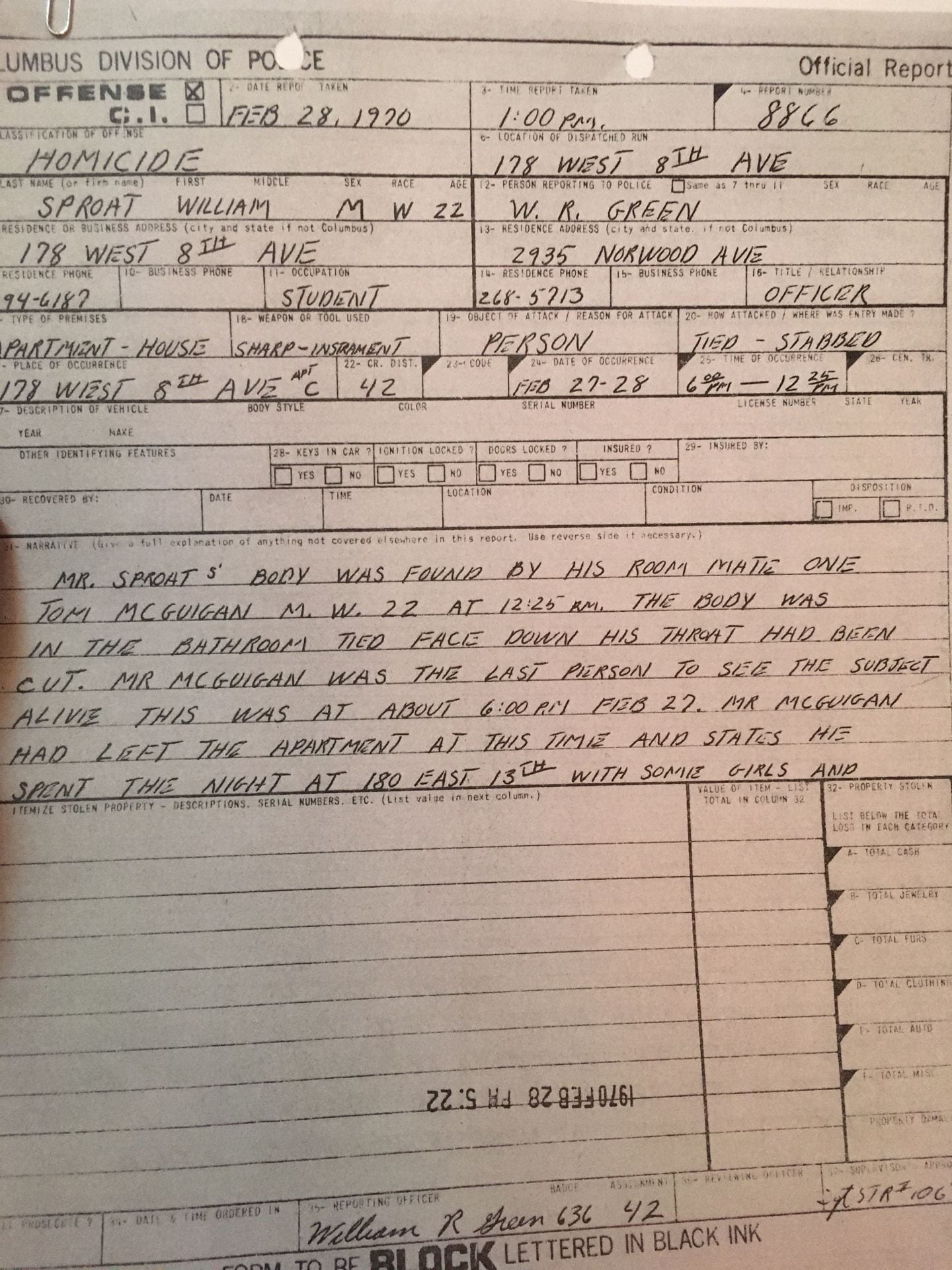
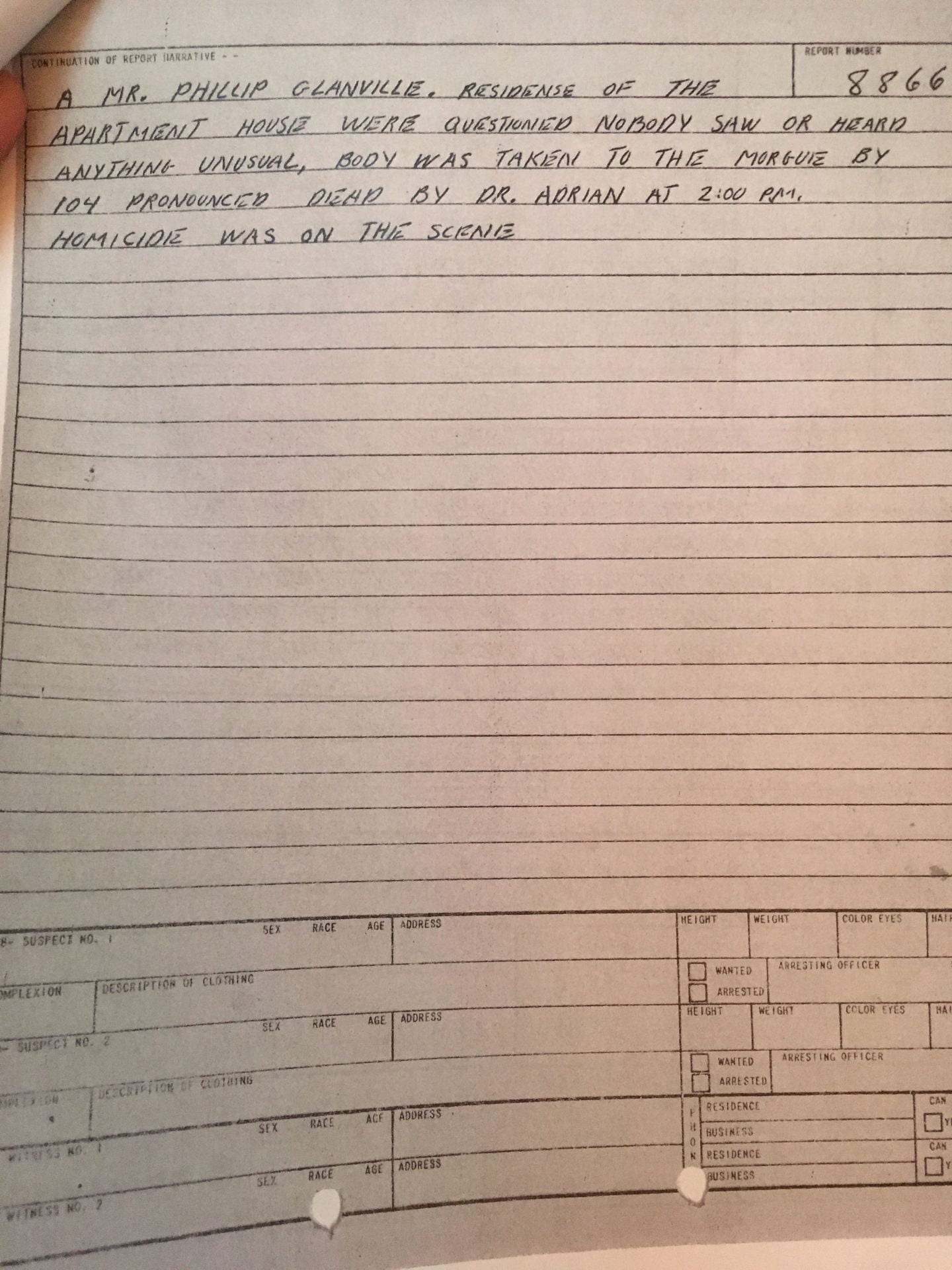

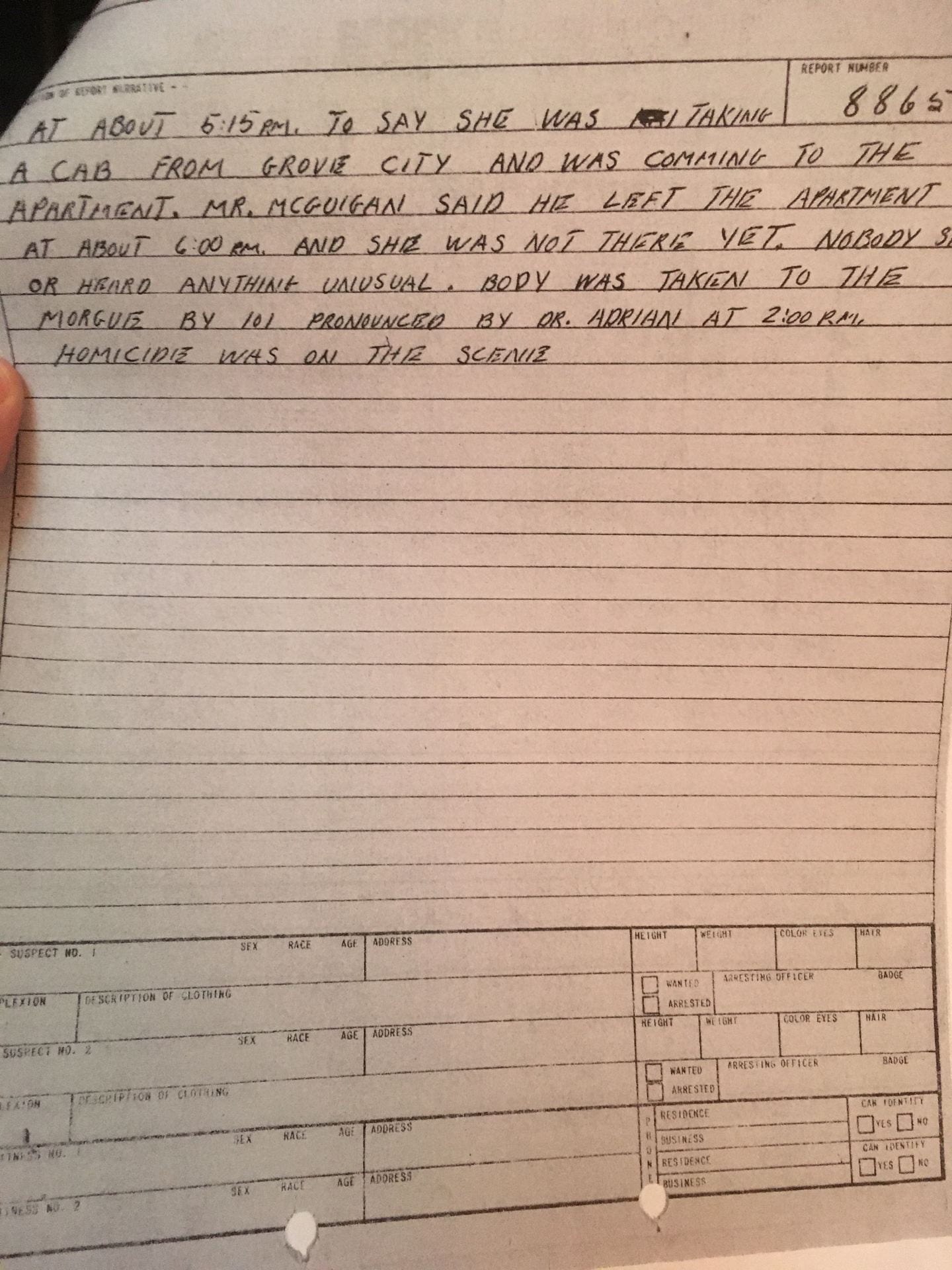
Original police reports from the Columbus Police Department detailing the way Sproat and Petry had been found
Courtesy of Justin Glanville
The Mary and Bill podcast highlights a range of possible motives from a serial rapist to a vengeful acquaintance punishing the Catholic couple for supposedly spending a night together that circulated throughout the decades but ultimately led to nothing.
Ohio State’s campus was struck by the brutality of the crime, however, with violent crime running rampant in the area — especially sexual assault — students were accustomed to the danger. Lou Heldman, a former Lantern reporter who covered the story when it first unfolded, said he is still shaken by what happened.
“On one hand, it was an absolutely horrifying crime. On the other hand, it wasn’t surprising,” Heldman said. “This was just so awful that it stuck with me all these years.”
According to Lantern archives, the slayings were the second and third in the area in the previous three months.
The first Lantern article about the murders also mentions a girl who was reported to have fought off a man who tried to force his way into her apartment the Saturday Sproat and Mary Petry were found. She lived half a block away.
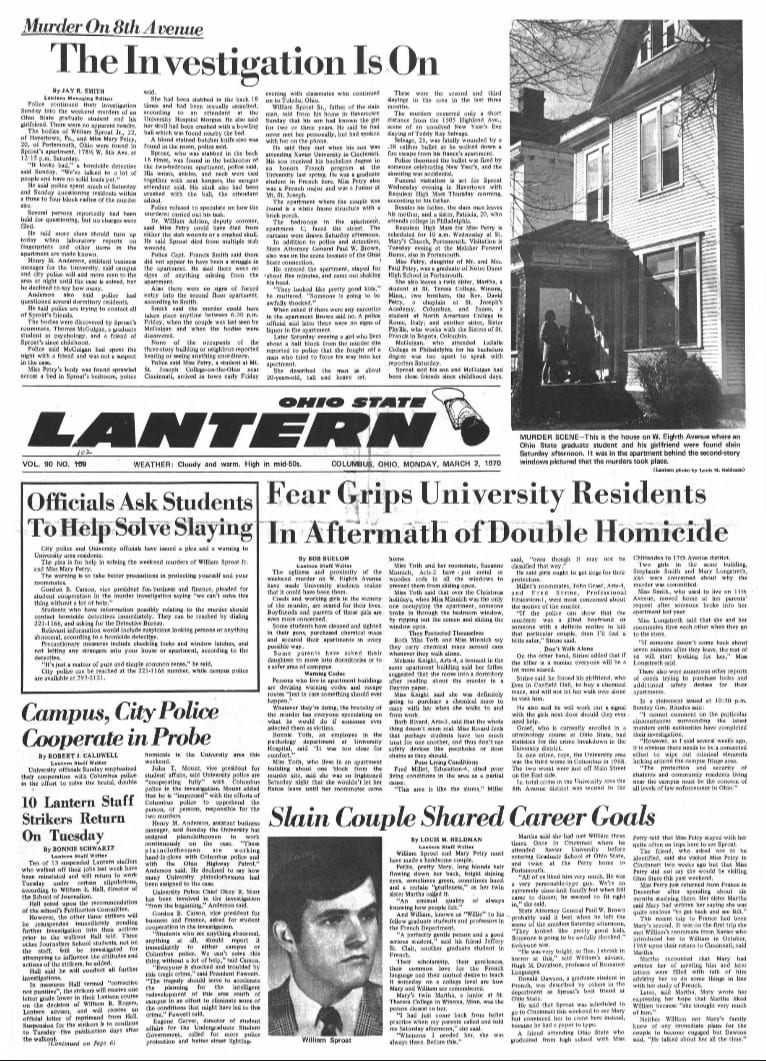

Lantern articles from 1970 when the case first unfolded (left) and months later detailing crime in the area (right)
Courtesy of Justin Glanville
Serious crime involving murder, sexual assault and aggravated assault was rapidly on the rise in recent years, according to an August 1970 Lantern crime report. In addition to Sproat and Mary Petry, Mary Margret Andrews was murdered in 1962, Teddy Ray Selvage was murdered in 1969 and Susan A. Clark was murdered in 1970. All but one remain unsolved.
Heldman said 1970 was a period of time where Ohio State was detached from student safety in the university area. According to archives, one Ohio State student told The Lantern the university area was “like the slums.”
The same Lantern crime report in 1970 highlighted the need for self defense as university coeds were becoming victims of rape, muggings and burglaries at an alarming rate. Police encouraged women to never walk alone, scream if in danger and even use defensive tactics to subdue an assailant.
“Columbus police consider fingernails one of a woman’s best weapons besides her vocal cords,” a Lantern reporter said in an article.
The fact that Mary Petry was sexually assaulted, according to the police report, not only pointed to a possible motive but frightened women in the area. One university employee who lived a block away from the murder told The Lantern the homicides were “too close for comfort” and began carrying chemical mace in addition to installing metal and wooden rods in her windows.
Severity of crime was so high that the university started to become involved in campus safety by providing services like extensive lighting systems that were installed in the campus area, according to the Lantern archive crime report.
Even so, Sproat and Mary Petry’s case faded in the midst of more acts of random violent crime on Ohio State’s campus. Although detectives never considered the case closed, they did affirm six months after the crime took place that a lack of witnesses made for little chance the case would be solved, according to Lantern archives.
Moreover, in the spring of 1970, Ohio State and campuses around the country were filled with a tremendous amount of civil unrest, Heldman said. Just a few months after the murders, the infamous Kent State shootings absorbed all of the media’s attention along with other tumultuous anti-war protests across the nation.
“Unfortunately, the murders kind of got lost in everything that happened afterward,” Heldman said.
Past investigations
Through the decades, Sproat and Mary Petry’s case has seen many surges of new developments that ultimately stalled, according to Lantern archives. In the earliest stage of the investigation, police were able to obtain what they believed to be objects used in the murder from the crime scene, including a bowling ball and a knife.
They also collected DNA from Sproat, Mary Petry and a third unknown source.
In addition to attempting to extract fingerprint DNA with lead dust, police have cycled through different persons of interest, produced a suspect sketch and even offered monetary rewards in exchange for information helpful to the case, according to a Lantern report.
As decades went on and investigative leads went stale, there was little hope the case would ever be solved.
According to the Bill and Mary podcast, since the families of the two did not reside in Columbus, they had a strong sense of trust in the investigative process that dissuaded them from taking more assertive steps with police despite a lack of answers.
Loeliger said she only received one letter from Ohio State expressing their condolences.
Friends eventually left the Columbus area, partially due to the haunting shock of what happened. Although loved ones never stopped searching for answers, they were left with no choice but to keep pushing through life.
That was until Justin Glanville, producer of the Bill and Mary podcast, played a crucial role in bringing the decades-long case back to the public and detective’s attention.
Glanville said as he began to make requests for documents related to the case when starting the podcast three years ago, coupled with the persistence of family members, Columbus police were influenced to make another effort at reviving the investigation.
Loeliger said thanks to Glanville’s strong interest in the case police have become invested in solving the ongoing investigation.
“Justin is phenomenal, he just opened Pandora’s box,” Loeliger said.
With the advent of new technology, known as investigative genetic genealogy, that can use familial DNA to identify suspects, Assistant Chief Greg Bodker of the Columbus Police Department said detectives are cautiously optimistic this cold case can still be solved.
“We believe that there’s evidence that, given today’s technology, may have an opportunity to lead to the identity of the people that were responsible for that crime,” Bodker said.
According to the podcast, preserved DNA from the 1970 crime scene is currently awaiting analysis through an investigative genetic genealogy lab until two other suspects can be ruled out.
Glanville said he grew up hearing the tale of the young couple whose lives were mercilessly taken because his parents were friends of Sproat. His father, Philip Glanville, had also visited Columbus the same weekend of Sproat and Mary Petry’s death to spend time with his girlfriend and now wife, Holly Glanville, an Ohio State student at the time.
“I remember hugging and crying, trying to imagine, but not wanting to, what happened,” Holly Glanville told the podcast.
Justin Glanville said his father became the police’s first suspect after arriving at the crime scene in the immediate aftermath of Sproat’s roommate discovering the bodies and calling him.
“This was a case that they talked about from time to time and they just always remembered it and it always haunted them as just this horrible thing from their past,” Justin Glanville said.
What initially started as brewing interest became a project that brings the story of Mary Petry and Sproat back to life. Justin Glanville said despite his curiosity as to why the murders had not been solved, his desire to share the story of Sproat and Mary Petry encouraged him to do the podcast.
“It requires great emotional energy to pursue the case,” Martha Petry said.
“It requires great emotional energy to pursue the case,” Martha Petry said. “Sgt. McConnell and Detective Gillette both visited me in my house, maybe a year and a half ago, and since then I don’t go on the website — I talk to Sgt. McConnell directly.”
Bodker said when looking into cold cases, detectives from the Homicide Case Review Unit assess the solvability of a case based on processed evidence. Given the age of the case, Bodker said eyewitness evidence is too weak to consider, which makes preserved DNA evidence the primary key to solving the case all these years later.
Given the age of the case, Bodker said eyewitness evidence is too weak to consider, which makes preserved DNA evidence the primary key to solving the case all these years later.
Where are we now?
Fifty-three years later, it is hard to tell how much progress has been made in the open investigation, and many questions still remain. The main one endures — what had Sproat and Mary Petry done to have their lives ripped away from them in such a heartless manner?
Martha Petry said as time has passed, the only justice she is interested in is knowing the reason behind the perpetrator’s actions because of how gruesome it was.
“I know that the why is connected with the person, but I still believe that this was a crime of passion because it was so horrendous,” Martha Petry said.
Though there is still uncertainty about what exactly happened the night of February 1970, it is known the couple’s love and dreams of a future in the city of love filled the walls of Sproat’s apartment until the last moment of their lives.
Martha Petry said despite the case remaining unsolved, she is grateful for the investigative work that is now underway.
Police may be able to finally identify the perpetrator of the crime but remaining details about the events of that night may be lost forever.
Details like how could such a brutal murder have taken place without a single person hearing? Who was that man the paperboy saw on his rounds to collect his earnings in the apartment? Would the couple still be alive if Sproat visited Mary Petry in Cincinnati instead?
What really happened in Apartment C on the night of Feb. 27, 1970?
Words by Amani Bayo
Web Design by Gaurav Law
